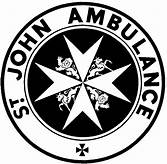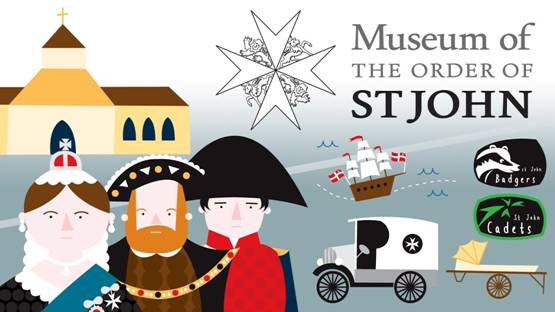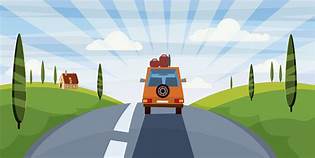
Salty Sam’s Fun Blog for Children
Number 492
St John Ambulance
Hello Everyone
Last week, we held the annual Rocky Bay Summer Fete.
A lot of summer fetes are held in June, before it gets too hot and before schools break up and most people go off on holiday.
But of course because we are a holiday destination we catch some tourists as extra visitors.
l think the whole town must have been there; it was very crowded.
The vicar organized the whole thing. There were lots of marquees, tents and stalls set up on the village green.
The grass was cut and the pond roped off before this could be done.
The Rocky Bay Primary School had their own stalls to raise funds for the school. Miss Pringle and the other teachers had the responsibility of setting them up and the children took it in turns to help collect money from any contestants or customers that turned up.
Auntie Alice entered a cake in the baking competition and Captain Jack put some of his vegetables in the gardening competition as usual.
They each won a prize as usual. ![]()
One very important tent set up near the entrance was the first aid tent. On a very hot day you may have seen people lying down inside a first aid tent because they have fainted.
Or you may have noticed the logo of St John on the TARDlS in Doctor Who.
The tent was manned by volunteers from St John Ambulance. You may have seen these volunteers at large events before; but you may not have realized that they belong to an organization that is nearly a thousand years old!
St John Ambulance is a charitable organization that teaches and administers first aid.
The Association was founded (started) in 1877 to provide first aid training.
This was mainly to help people in factories and others working with heavy machinery who could have accidents when a doctor was not to hand to help out in the emergency. Without rapid aid they could have been disabled; or they may have even died.
ln 1887, the Brigade was founded to provide medics at public events.
They wear a uniform so that they can be spotted easily if you need help.
St John Ambulance was often the only provider of ambulances before the National Health Service was formed in 1948. Their nurses often looked after ill and injured patients in their own homes because there weren’t as many hospitals as there are today.
Their members were a huge support in the two world wars last century (joining forces with the Red Cross) providing ambulances and first aid training. They also provided volunteer-driven ambulances during the Covid-19 crisis of 2020 or the health service strikes that followed.
The Association and the Brigade joined into the present organization in 1968. lt operates under the Order of St John.
lt trains thousands of adults and children to understand how to administer first aid properly.
lt treats thousands of people at thousands of events each year.
They will be at shows, horse races, football matches and even riots and terrorist attacks. The volunteers are on hand to help in places where large crowds gather. They may deal with people who have fainted or been stung by an insect but they may also be there to save someone’s life too.
The Order was first seen working in public like this at Queen Victoria’s Golden Jubilee celebrations in 1887. The medics were also at the 1908 London Olympics.

The Order of St John was a group of English monks who founded a St John hospital in Jerusalem in about 1070; it is one of the oldest service organizations in the world.
The men and women who worked in the hospital under a man named Brother Gerard were members of a new religious order; later officially recognized by the Catholic Church in 1113.
They were known as the Hospitallers.
The hospital was set up to care for Christians coming to Jerusalem on a religious pilgrimage to this holy city. The journey from Europe to Jerusalem was long and arduous, and many people, whether religious pilgrims or the soldiers called crusaders could become ill or get injured on the way. But the Hospitallers helped anyone who needed medical attention no matter what their faith was.
The Order developed into a religious and military order which would defend Christians in their care. The members were called Brother Knights.
The Order was driven out from Jerusalem in 1187.
lt set up new headquarters on the coast of Palestine. lt was later driven out by Muslim forces in 1291.
lt then moved to the Mediterranean island of Cyprus for a while and then on to Rhodes in Greece where it stayed until it was driven out by the Turks in 1522.
The Order moved to Malta in 1530, where its medical work continued. A ward in the hospital in Malta was the longest room in any building in 18th century Europe.
The Order was then forced out by Napoleon in 1798. By the middle of the 1800s, it had established a new headquarters in Rome.
But from the beginning, the Order had also been given land throughout Western Europe and this property grew to be quite extensive over time. The estates were managed by small communities of religious brothers and sisters.
ln Britain, the estates were controlled by one of the communities in Clerkenwell (pronounced Clarkenwell) in London which had been set up in the 1140s.
The buildings would be later put to many uses over the years, becoming a coffee house and then a pub where artists and writers including Charles Dickens used to meet up. There is now a museum and garden for people to visit. ln the garden grow many medicinal herbs of the type the monks would have used to treat their patients. (The church with crypt can be visited by appointment.)
The Order was suppressed in 1540 by Henry Vlll when he set up the Anglican Church and ordered the Dissolution of the Monastries; but restored by his daughter, the Catholic Queen Mary l, in 1557.
Although Queen Elizabeth l, her sister, took all the estates away from the Order again in 1559, the organization survived.
ln the 1820s, the Knights of Malta, as they were now called, that were living in France, offered knighthoods to specific people supporting the Order in Britain. These English knights dedicated their lives to charitable activities which were dealt with by organizations called Foundations. We still have charitable foundations set up today.
Queen Victoria recognized this group officially in 1888. They became known as the Order of St John.
Victoria ruled a large empire in those days, and the Order took western medical practices to the Colonies; consequently, it is now active in over 40 countries across the globe.
The national branches are still called priories. A priory is a word usually used to describe a residence for monks and nuns.
The Order of St John is formally called the Most Venerable Order of the Hospital of Saint John of Jerusalem. lt is an international order of chivalry which has its headquarters in Britain.
Chivalry means the standards of behaviour expected of knights of the Middle Ages. The knights were expected to have great military skills and also be brave, kind, civilized and well-mannered. They were supposed to show great courtesy to women – and nowadays the word chivalry is usually used to mean men showing great politeness to women.
The St John Ambulance Cadets were formed in the 1920s for girls and boys aged 11 to 18 offering first aid training to those who were too young to join the adult classes.
The Badgers programme for young children was introduced in 1987.
First Aid Awards were launched in 2010.
There is a free smart phone app that people can download if they don’t want to attend classes.
First aid is an important skill to learn.
lf you like my blog, please support it by telling all your friends and followers about it.
Thank you!
And see you again next Fun Friday!
Love and kisses
Salty Sam

www.christina-sinclair.com


Bill and Bob’s Joke of the Week![]()
![]()
Bob: A man goes to the hospital, and the doctor asks, “So what brought you here?”
Bill: And the man says?
Bob: “An ambulance.”
So the doctor says, “No, no, l mean what are your symptoms?”
“Well, l think l’ve got bird flu,” replies the man.
“Oh, don’t worry,” says the doctor. “That is very tweetable!”

Salty Sam © Christina Sinclair 2015
Unauthorized use and/or duplication of material from this blog without express and written permission from this blog’s author and owner is strictly prohibited.
Links may be used to www.christina-sinclair.com

Picture Gallery
 Emblem of humanitarian care
Emblem of humanitarian care
 An ancient order of knights
An ancient order of knights
 Queen Elizabeth II
Queen Elizabeth II
 Jerusalem
Jerusalem
 The Museum
The Museum
 The crypt under the church
The crypt under the church



 THE SALTY SAM NEWS DESK
THE SALTY SAM NEWS DESK

This week, Miss Pringle gave her class a quick quiz. Can you answer her questions?
What do these idioms mean?
- An uphill struggle
- Standing at the crossroads
- To be off track
- No turning back
- Running on empty
- A dead-end job
- To go off the rails
- To follow in someone’s footsteps
- Going nowhere fast
- Running out of steam


*********************
*********************

 Quick Quiz
Quick Quiz
Do you know CPR procedure?




lt’s the Weekend!

HOW TO MAKE A BELTED JACKET FOR A 12” DOLL
This is a smart red jacket for casual wear.
The white top can be found on Blog Post 390.
JACKET BACK (KNIT ONE)
Using 4mm knitting needles and red dk yarn cast on 16 stitches
Knit 2 rows of garter stitch
Knit 30 rows of stocking stitch
Knit 2 rows of garter stitch
Cast off
JACKET FRONT (KNIT ONE)
Using 4mm knitting needles and red dk yarn cast on 8 stitches
Knit 2 rows of garter stitch
Knit 1 row
Purl 6, knit 2
Repeat these last 2 rows 14 times
Knit 2 rows of garter stitch
Cast off
JACKET FRONT (KNIT ONE)
Using 4mm knitting needles and red dk yarn cast on 8 stitches
Knit 2 rows of garter stitch
Knit 1 row
Knit 2, purl 6
Repeat these last 2 rows 14 times
Knit 2 rows of garter stitch
Cast off
SLEEVES (KNIT TWO)
Using 4mm knitting needles and red dk yarn cast on 12 stitches
Knit 2 rows of garter stitch
Knit 18 rows of stocking stitch
Cast off
JACKET BELT (KNIT ONE)
Using 4mm knitting needles and red dk yarn cast on 3 stitches
Knit 90 rows of garter stitch
Cast off
TO MAKE UP
Sew the lapels down
Then with right sides together using over-sew stitching
- Sew up shoulder seams
- Sew the tops of the sleeves in place
- Sew up side seams and under arm seams
BLACK TROUSERS (KNIT TWO)
Using 4mm knitting needles and black dk yarn cast on 16 stitches
Knit 2 rows of garter stitch
Knit 36 rows of stocking stitch
Cast off 2 stitches at the beginning of the next 2 rows of stocking stitch
Knit 8 rows of stocking stitch
Change to 3¾mm knitting needles
Knit 4 rows of 1×1 rib
Cast off
TO MAKE UP
With right sides together using over-sew stitching sew up front and back seams then sew the inside legs

Please note that the material on this blog is for personal use and for use in classrooms only.
It is a copyright infringement and, therefore, illegal under international law to sell items made with these patterns.
Use of the toys and projects is at your own risk.
©Christina Sinclair Designs 2015

Answers to the News Desk Quiz
- An uphill struggle – something is very difficult to do
- Standing at the crossroads – having to make a choice as to how you are going to go forward
- To be off track – to not be going in the right direction
- No turning back – to get so far into a project that you feel that you cannot give up on it
- Running on empty – being hungry or having no strength or resources left
- A dead-end job – a job with no prospects of bettering yourself
- To go off the rails – to get into trouble or break the law or choose a dangerous lifestyle with bad choices
- To follow in someone’s footsteps – to do something that someone else has done like a certain career
- Going nowhere fast – trying and failing or not even trying
- Running out of steam – using up what energy you have left fast



Quick Quiz Answers
- Call for an ambulance = 999 or 911 or 000 – whatever is right for the country you are in
- Position hands at the centre of the chest
- Press down 30 times – use rhythm of Staying Alive track
- Tilt head, lift chin, check tongue is not restricting airway, and see if the patient is breathing
- Blow 2 breaths into the patient, pump chest 30 times, blow 2 breaths and pump again – keep going until the patient is responding, the ambulance will be on its way to help you
- When heart and breathing is alright, put the patient into the recovery/security position – that is on their side with one leg crooked up to support the body position and you can see where the arms go in the picture

ln order to know the right rhythm to use play this track in your brain
https://www.youtube.com/watch?v=fNFzfwLM72c
(and yes everyone was this thin before fast food was invented!)


